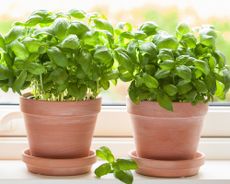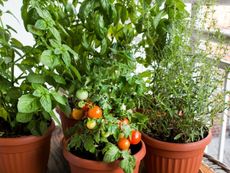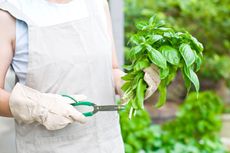Herbs
Whether just starting out, looking for growing info, or need help identifying edible herbs, you’ve come to the right place. There are a number of herbs that can be grown in the garden—some for medicinal reasons, some for aesthetic reasons, and others being common herbs you can eat, cook with or use in teas. Learning how to grow herbs is easy, and with the right know how, identifying edible herbs will become second nature. So whatever the reason, we can help with all your herb growing needs.
Herbs
-

How To Grow Basil Indoors – For Fresh Year-Round Flavor
While basil is a commonly grown herb outdoors, this easy-care plant can also be grown indoors. Read the article that follows to get tips and information on how to grow basil indoors.
By Nikki Tilley
-

Hardy Winter Herbs: Cold-Hardy Herbs For Outdoors
A cold climate herb garden may take a serious hit from frost and snow. Luckily, there are plenty of herbs that can withstand the cold, as well as ways to protect those that can't. This article will help with tips on caring for herbs in cool climates.
By Liz Baessler
-

Puntarelle Chicory: Complete Guide To Growing Puntarelle
If chicories are at the bitter end of the salad spectrum, puntarelle chicory is the most beautifully biting of the lot. Here's how to grow your own.
By Amy Grant
-

How And When To Harvest Garlic
Harvest garlic when at least one third of the leaves have dried and turned brown. Dig the bulbs out with a trowel - don't pull!
By Heather Rhoades
-

Why Fall Garlic Planting Is The Best Method
Fall is a great time to get garlic planted in the garden. Cold weather gives it a good start for a rich aromatic spring harvest.
By Amy Grant
-

Best Companion Plants For Thyme In The Garden
While companion planting isn’t an exact science, thyme proves to be one of the best companions for some, but not all garden plants.
By Amy Grant
-

Best Sage Companion Plants In The Garden
Sage is a great companion for many garden plants, encouraging pollinators and repelling pests. Read more about sage for companion planting.
By Amy Grant
-

Companion Planting In Your Herb Garden
We all know the benefits of vegetable companion planting, but what about growing herbs as companion plants? Click here to learn more.
By Mary H. Dyer
-

Homegrown Mint Benefits Your Health
Click here and learn how homegrown mint benefits your health.
By Bonnie L. Grant
-

Bolting Cilantro - Why Does Cilantro Bolt And How To Stop It
Cilantro always bolts eventually, but here are some tips about getting the best from this delicious herb and how to keep it going.
By Heather Rhoades
-

Lavender Container Care: Tips On Growing Lavender In Pots
Lavender is a beautiful herb to grow in pots, planters or other containers. Read on for tips on the best practices.
By Liz Baessler
-

Uses For Dandelions: What To Do With Dandelions
Dandelions are considered weeds by many people, but they're actually useful. Consider all the uses for dandelions before dismissing them.
By Mary Ellen Ellis
-

Garlic As Pest Control: Tips For Controlling Pests With Garlic
Insects either love garlic or detest it. Some don't mind it, but others avoid it like the plague. Learn how to use it to your advantage here.
By Amy Grant
-

Mint Plant Companions – What Plants Grow Well With Mint
If you have herbs, you probably have mint. But what should you be growing your mint next to? Click for mint companion planting tips.
By Amy Grant
-

Trimming Basil Leaves: Tips For Cutting Back Basil Plants
Basil plants are known for their outstanding aromas. The leaves of this herb have a high concentration of essential oils, making it a great addition to various cuisines. What then is the best way of pruning back basil plant leaves? Find out here.
By Amy Grant
-

Tips On St. John’s Wort Pruning: When To Cut Back St. John’s Wort
St. John's flowers more prolifically if you prune it once a year. Click here for information about St. John's wort pruning.
By Teo Spengler
-

Potted Chamomile Plants – How To Grow Chamomile In A Container
Growing chamomile in containers is perfect if you're worried the generous self-seeder may be too rambunctious in the garden. Click fore more.
By Mary H. Dyer

